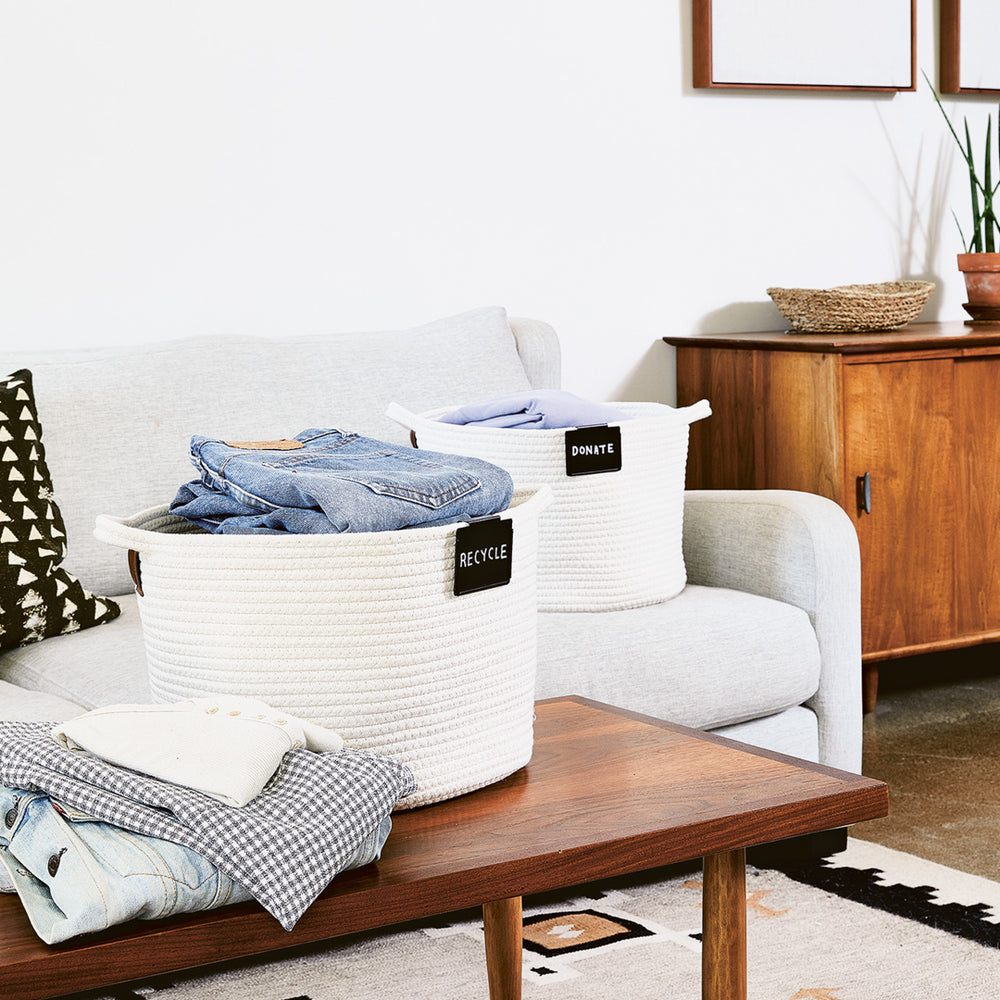With the surge in popularity of home organization Netflix shows, like Get Organized with the Home Edit and Tidying up with Marie Kondo, tons of people have been inspired to declutter their space and purge unnecessary belongings that don’t ‘spark joy.’ And, as it turns out, streamlining your home is very compatible with a low-waste lifestyle—the less things you own and the more minimal your space, the more likely you are to appreciate and care for the belongings that you actually do use and enjoy. The decluttering process also exposes our wasteful habits—you may realize that you’ve bought duplicate items, or guiltily stumble upon expensive purchases that have never seen the light of day. Rather than beating yourself up for past mistakes, take this exercise as an opportunity to become a more mindful consumer moving forward. And, there’s no better time to cleanse and organize your home than this spring!
Here are 5 low-waste tips that will help you declutter and reset your home with intention:
1. Purge Thoughtfully
You’re ready to cleanse your wardrobe after piling all of your clothes and accessories on the bed (and wow, there’s a lot of stuff). After going through each item (sparks joy, keep...doesn’t spark joy, donate) you have a huge pile for donations. Ideally, you will be able to donate most items you're ready to part with, but what about that ratty t-shirt with stains or those grubby sneakers you used to garden in? Take care to not pass the burden of disposing these items onto your local thrift shop. The clothing, electronics and other household supplies that aren’t in good working condition are often sent to landfill because they have no resale value for the store. Always check with your local second hand shop to make sure you are donating items they actually need. And, for items that are past their prime, look into recycling. Textiles in any condition can be recycled at drop-off bins at H&M stores, any brand of sneakers can be repurposed through Nike’s Reuse-A-Shoe program (and even turned into new products!) and broken electronics can be recycled at Best Buy.
2. Make it Manageable
When we get bit by the organization bug, it can be tempting to tackle the entire home in one fell swoop. But as we go through the process, and realize how much there is to do, we can get burned out and give up entirely. Decluttering takes time, patience and a plan (and good snacks and music, of course). Take a cue from professional organizer Shira Gill who recommends the "15-minute win"—setting a clock for 15 minutes and tackling one small area at a time. Breaking up a large project into smaller tasks will help keep you fresh and focused, and you’ll get instant gratification from checking the job off your list. Go around your home to determine what areas need attention (ie kitchen pantry, garage, entryway, closet, etc), write everything down and think about how you can break up large tasks up into smaller chunks. For example, “Today I will tackle my junk drawer and tomorrow, the fridge.”
3. Let Go of Guilt
The expensive bridesmaid dress you bought for a friend’s wedding, the shoes that are a little too tight, the gifted necklace that isn’t quite your style. There are many reasons we hold onto things and have difficulty letting go, including guilt over being wasteful with our money and a sense of obligation to hold onto gifts. Unfortunately, storing items for the unlikely event that something will change (maybe my feet will shrink?) does more harm than good. Let go of these unused belongings and the guilt that comes with them, and think of it as a teaching moment for becoming a more mindful consumer. To help ease the process, try to sell items that have value through Buy, Sell, Trade (BST) groups, Facebook Marketplace, NextDoor, Poshmark, Ebay or Craigslist. Receiving monetary compensation for letting go will help ease your guilt, though don’t expect to recoup your entire investment.
4. Hold Off on Supplies
When you think of an organized home, you might be picturing kitchen pantries and playrooms with lots of matching bins, neat labels and rainbow categorization. And, when you start to organize your own space, it can be enticing to go out and buy a bunch of fancy new supplies so you’ll have a system for corralling these loose objects. Stop right there. Buying supplies should be the very last step of decluttering, or skipped entirely. Once you’re done purging, you may discover that you can utilize newly spacious drawers and built ins that you already have, or discover items you can repurpose like cardboard shoe boxes, metal tea tins and empty jam jars. Also, give yourself time to sit with your newly decluttered space as you might find that you’re ready to part with more things after a few days. And, if you absolutely do want bins or baskets, try to stick with sustainable materials like metal wire or woven baskets, especially ones found secondhand.
5. Do It Often
If you’ve lived in the same space for many years, and put off decluttering until now, expect that the entire process may take weeks to complete. But after you’ve done it once, don’t stop there. Plan to go through your space 2-4 times a year, ideally at the start of each new season. It’s helpful to do it seasonally because it’s often a time of transition for our homes—winter clothes and gear are ready to be tucked away, school is about to start and kids’ bedrooms need a refresh to prepare for busy schedules. And, like anything, the more you do it the easier it gets. For ongoing maintenance, keep dedicated donate / recycle / sell bins that you can add to. It’s also helpful to stow these bins someplace that will remind you to take care of them (ie drop off donations / recyclables) so they don’t pile up and become unmanageable.

